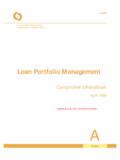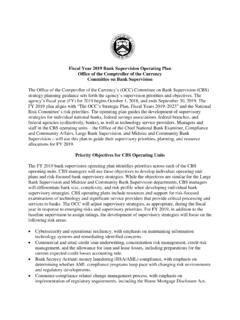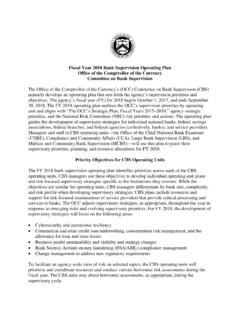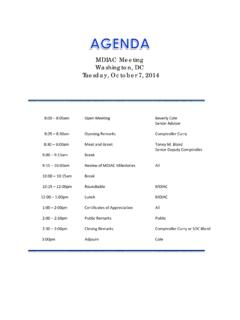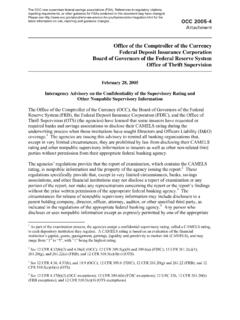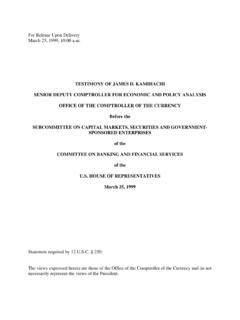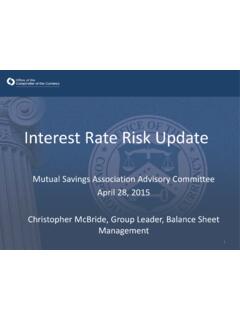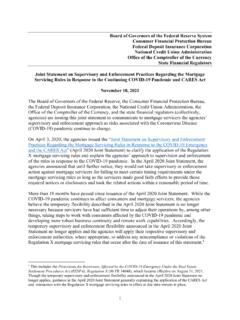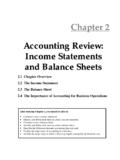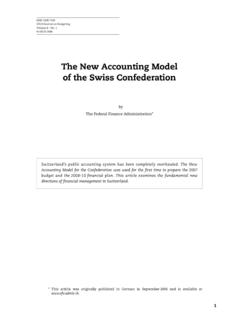Transcription of Bank Accounting Advisory Series 2018 - OCC: Home Page
1 bank Accounting Advisory SeriesAugust 2017 bank Accounting Advisory Series i August 2017 Message From the Chief Accountant I am pleased to present the Office of the Chief Accountant s August 2017 edition of the bank Accounting Advisory Series (BAAS). The BAAS expresses the office s views on Accounting topics relevant to national banks and federal savings associations (collectively, banks or institutions, unless otherwise specified). We hope that you find this publication useful. In the past, our office has updated the BAAS for newly issued Accounting standards after they became effective. We are changing our approach beginning with this edition of the BAAS, because many Accounting Standards Updates (ASU) issued by the Financial Accounting Standards Board (FASB) now have different effective dates for public business entities (PBE) and private companies.
2 This edition reflects ASUs issued by the FASB through March 31, 2017, that, (1) while not yet effective for all institutions, must be adopted by PBEs beginning in 2018 and may be adopted early by other institutions or (2) are not yet effective for any institutions but early adoption is allowed. To differentiate these two scenarios, we have added two color schemes lavender for content applicable to PBEs and early adopters and gold for content applicable to early adopters only. The responses in lavender and gold text boxes replace the initial staff responses for applicable entities and should not be read in conjunction with the original staff responses. The following questions have been added, updated, or deleted in the 2017 edition of the BAAS: NEW Topic 1A Investments in Debt and Equity Securities Questions 16, 17, and 18 Topic 3B Lessee Classification and Accounting Questions 1, 2, 3, 4, and 5 Topic 9A Transfers of Financial Assets and Servicing Questions 8, 9, and 10 UPDATED Topic 1A Investments in Debt and Equity Securities Questions 6, 7, and 20 Topic 1B Other-Than-Temporary Impairment Questions 3, 7, and 20 Topic 3A Lessor Classification and Accounting Questions 1, 2, 3, 4, 5, and 11 Topic 3C Sale-Leaseback Transactions Questions 1, 3, 4, 5, and 6 Topic 3D Lease Exit Costs Questions 1, 2, and 3 Topic 5A Other Real Estate Owned Questions 13, 14, 15, 16, 17, 18, 21, 22, 23, 24, 25, 29, 30, 38, and 39 Topic 9A Transfers of Financial Assets and Servicing Question 7 DELETED Topic 1A Investments in Debt and Equity Securities Questions 16, 17, 18, 19, 20.
3 And 21 Topic 1B Other-Than-Temporary Impairment Questions 17 and 18 Topic 2C Commitments Question 3 As part of our annual review process, we also made minor edits to some existing entries and renumbered others. bank Accounting Advisory Series ii August 2017 Banks are reminded that the BAAS does not represent official rules or regulations of the Office of the Comptroller of the Currency (OCC). Rather, the BAAS represents the OCC Office of the Chief Accountant s interpretations of generally accepted Accounting principles and regulatory guidance based on the facts and circumstances presented. Nevertheless, banks that deviate from these stated interpretations may be required to justify those departures to the OCC. Louis A. (Rusty) Thompson Jr. Deputy Comptroller and Chief Accountant Office of the Comptroller of the Currency bank Accounting Advisory Series iii August 2017 Contents Message From the Chief Accountant.
4 I Topic 1 Investment Securities .. 1 1A. Investments in Debt and Equity Securities .. 1 1B. Other-Than-Temporary Impairment .. 13 Topic 2 Loans .. 23 2A. Troubled Debt Restructurings .. 23 2B. Nonaccrual Loans .. 49 2C. Commitments .. 65 2D. Origination Fees and Costs .. 74 2E. Loans Held for Sale .. 79 2F. Loan Recoveries .. 89 2G. Acquired Loans .. 92 Topic 3 Leases .. 99 3A. Lessor Classification and Accounting .. 99 3B. Lessee Classification and Accounting .. 107 3C. Sale-Leaseback Transactions .. 111 3D. Lease Exit Costs .. 116 Topic 4 Allowance for Loan and Lease Losses .. 118 Topic 5 OREO and Other Assets .. 148 5A. Other Real Estate Owned .. 148 5B. Life Insurance and Related Deferred 174 5C. Miscellaneous Other Assets .. 178 Topic 6 Liabilities .. 183 6A. Contingencies .. 183 6B. Other Borrowings .. 186 Topic 7 Income Taxes.
5 188 7A. Deferred Taxes .. 188 7B. Tax Sharing Arrangements .. 192 7C. Marginal Income Tax Rates .. 195 bank Accounting Advisory Series iv August 2017 Topic 8 Capital .. 197 8A. Sales of Stock .. 197 8B. Quasi-Reorganizations .. 199 8C. Employee Stock Options .. 201 Topic 9 Income and Expense Recognition .. 202 9A. Transfers of Financial Assets and Servicing .. 202 9B. Credit Card Affinity 213 9C. Organization Costs .. 214 Topic 10 Acquisitions, Corporate Reorganizations, and Consolidations .. 217 10A. Acquisitions .. 217 10B. Intangible Assets .. 226 10C. Pushdown Accounting .. 233 10D. Corporate Reorganizations .. 237 10E. Related Party Transactions (Other Than Reorganizations) .. 239 Topic 11 Miscellaneous Accounting .. 244 11A. Asset Disposition Plans .. 244 11B. Hedging Activities .. 246 11C. Financial Statement Presentation.
6 248 11D. Fair Value Accounting .. 249 Appendixes .. 254 Appendix A. Commonly Used Abbreviations and Terms .. 254 Appendix B. Commonly Used Pre-Codification References .. 256 Appendix C. Commonly Used FASB Codification 260 INVESTMENT SECURITIES 1A. Investments in Debt and Equity Securities bank Accounting Advisory Series 1 August 2017 Topic 1 Investment Securities 1A. Investments in Debt and Equity Securities Facts Under ASC 320, banks classify their investments in debt securities in one of three categories: HTM, AFS, or trading. HTM securities are carried at amortized cost, while AFS and trading securities are carried at fair value. Banks include the net unrealized holding gains (losses) on AFS securities in AOCI, net of applicable taxes, rather than as part of the bank s net income (loss). If HTM or AFS debt securities are other-than-temporarily impaired, banks must determine the amount of impairment to be recognized in earnings.
7 Net unrealized holding gains (losses) on trading securities are reported in net income (loss). Question 1 Should the net unrealized holding gains (losses) on AFS debt securities be included in the calculation of a bank s lending limit? PBEs and early adopters only In January 2016, the FASB issued ASU 2016-01, Financial Instruments Overall (Subtopic 825-10): Recognition and Measurement of Financial Assets and Liabilities. This guidance creates Topic 321, Investments Equity Securities, which addresses Accounting and reporting for investments in equity securities. ASU 2016-01 is effective for fiscal years beginning after December 15, 2017, including interim periods within those fiscal years, for banks that are PBEs. For banks that are not PBEs, the guidance is effective for fiscal years beginning after December 15, 2018, and for interim periods within fiscal years beginning after December 15, 2019.
8 Early adoption of the provisions of the standard involving Accounting for equity investments is prohibited. The following staff responses comply with existing GAAP guidance; to the extent that staff interpretations differ under ASU 2016-01, these are provided in separate lavender text boxes. Early adopters only In March 2017, the FASB issued ASU 2017-08, Receivables Nonrefundable Fees and Other Costs (Subtopic 310-20): Premium Amortization on Purchased Callable Debt Securities. ASU 2017-08 is effective for fiscal years beginning after December 15, 2018, including interim periods within those fiscal years, for banks that are PBEs. For banks that are not PBEs, the guidance is effective for fiscal years beginning after December 15, 2019, and for interim periods within fiscal years beginning after December 15, 2020. Early adoption is permitted for all banks.
9 The following staff responses comply with existing GAAP guidance; to the extent that staff interpretations differ under ASU 2017-08, these are provided in separate gold text boxes. INVESTMENT SECURITIES 1A. Investments in Debt and Equity Securities bank Accounting Advisory Series 2 August 2017 Staff Response It depends on the regulatory capital treatment of net unrealized holding gains (losses) on AFS debt securities for the bank . A bank s legal lending limit is the amount that the bank may legally lend to one customer. It should be calculated, in accordance with 12 CFR 32, based on the bank s tier 1 and tier 2 capital calculated under the applicable risk-based capital standards (set forth at 12 CFR 3 and presented in call report instructions), adjusted to include the portion of the ALLL excluded for tier 2 capital calculation purposes.
10 Under the 2013 revised regulatory capital rule, banks may be required to incorporate net unrealized holding gains (losses) on AFS debt securities into common equity tier 1 (CET1) capital, which is a component of tier 1 capital, as described below. For non-advanced approaches banks Under the 2013 revised regulatory capital rule, non-advanced approaches banks had a one-time irrevocable option to exclude ( filter ) certain AOCI components, comparable to the regulatory capital treatment before the 2013 revised regulatory capital rule. The AOCI opt-out election had to be made on the bank s first call report filed after January 1, 2015. For any bank that did not exercise this option, its AOCI will be incorporated into CET1 capital, including unrealized gains and losses on all AFS securities, subject to a transition period through December 31, 2017.

